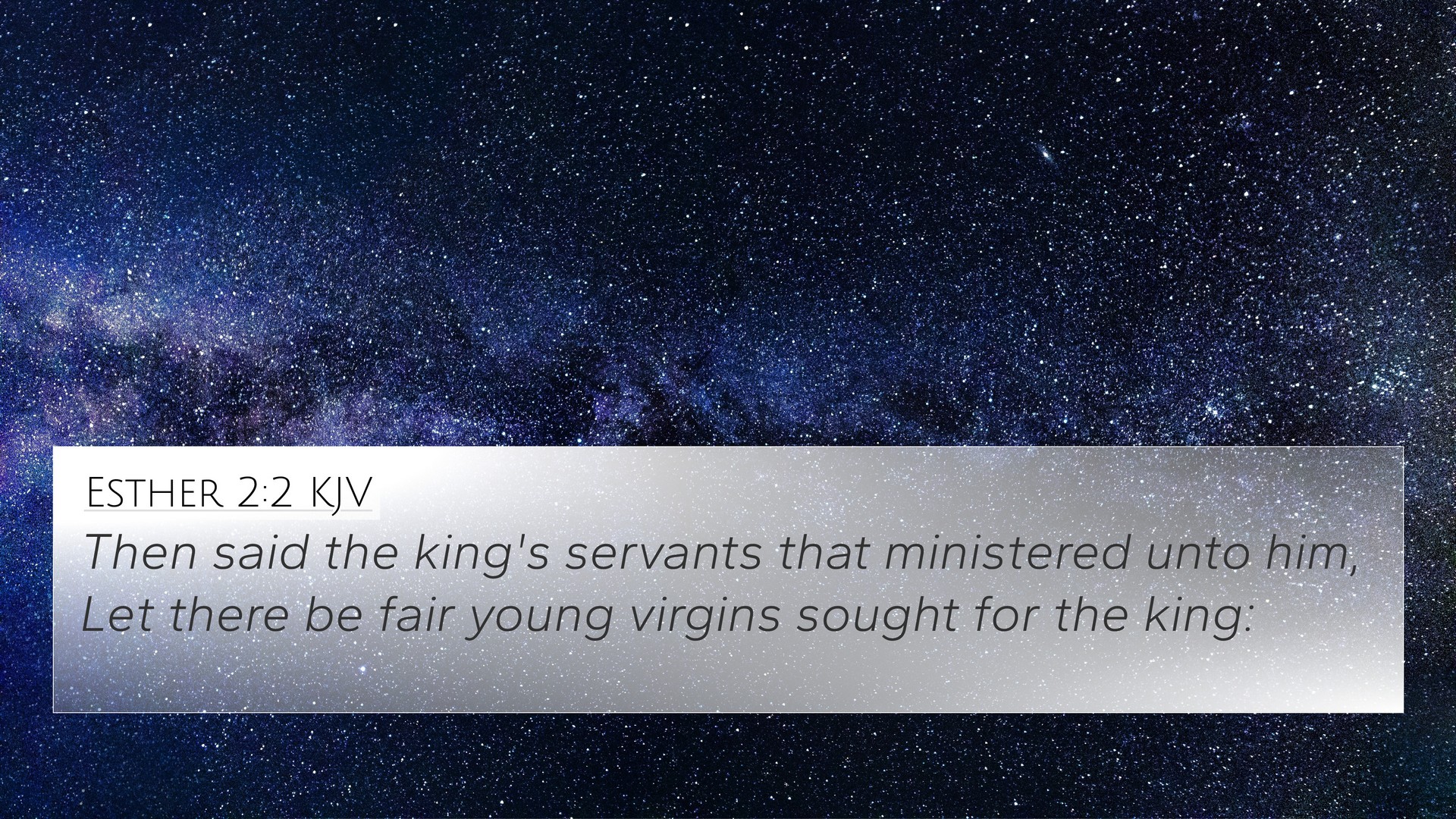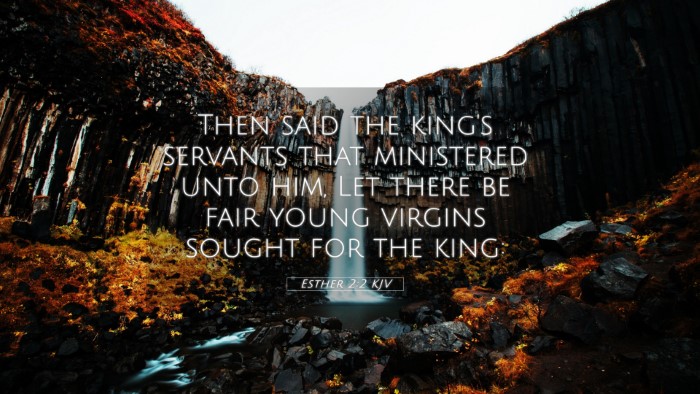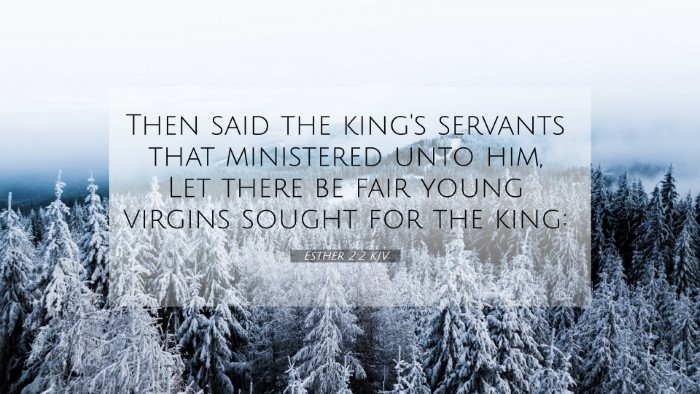Old Testament
Genesis Exodus Leviticus Numbers Deuteronomy Joshua Judges Ruth 1 Samuel 2 Samuel 1 Kings 2 Kings 1 Chronicles 2 Chronicles Ezra Nehemiah Esther Job Psalms Proverbs Ecclesiastes Song of Solomon Isaiah Jeremiah Lamentations Ezekiel Daniel Hosea Joel Amos Obadiah Jonah Micah Nahum Habakkuk Zephaniah Haggai Zechariah MalachiEsther 2:2 Similar Verses
Esther 2:2 Cross References
Then said the king's servants that ministered unto him, Let there be fair young virgins sought for the king:
Uncover the Rich Themes and Topics of This Bible Verse
Listed below are the Bible themes associated with Esther 2:2. We invite you to explore each theme to gain deeper insights into the Scriptures.
Esther 2:2 Cross Reference Verses
This section features a detailed cross-reference designed to enrich your understanding of the Scriptures. Below, you will find carefully selected verses that echo the themes and teachings related to Esther 2:2 KJV. Click on any image to explore detailed analyses of related Bible verses and uncover deeper theological insights.
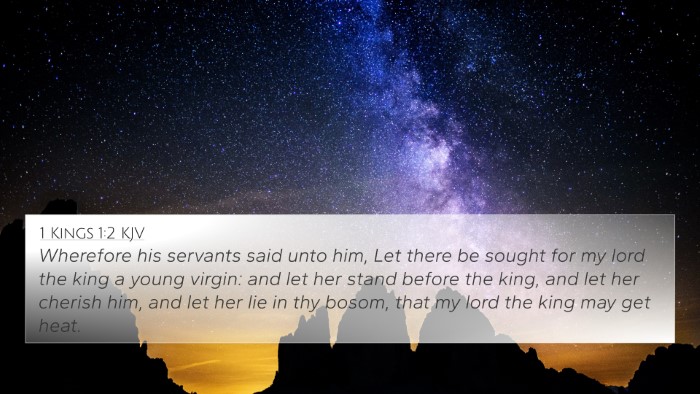
1 Kings 1:2 (KJV) »
Wherefore his servants said unto him, Let there be sought for my lord the king a young virgin: and let her stand before the king, and let her cherish him, and let her lie in thy bosom, that my lord the king may get heat.
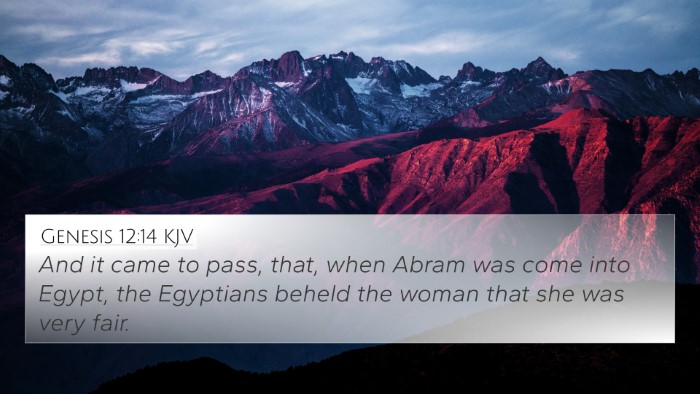
Genesis 12:14 (KJV) »
And it came to pass, that, when Abram was come into Egypt, the Egyptians beheld the woman that she was very fair.
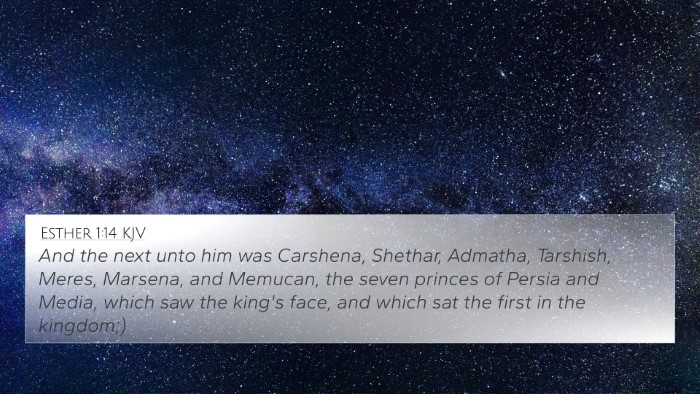
Esther 1:14 (KJV) »
And the next unto him was Carshena, Shethar, Admatha, Tarshish, Meres, Marsena, and Memucan, the seven princes of Persia and Media, which saw the king's face, and which sat the first in the kingdom;)
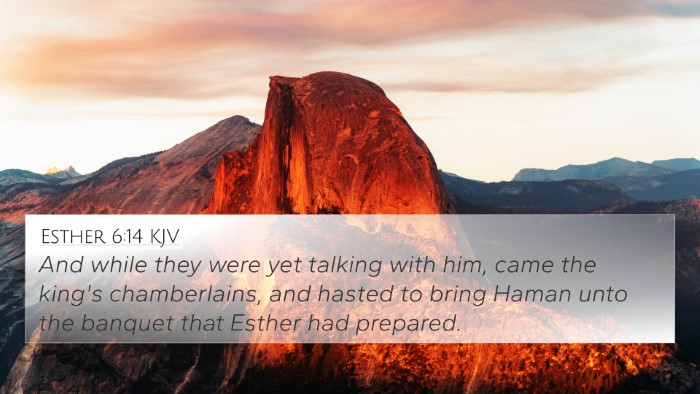
Esther 6:14 (KJV) »
And while they were yet talking with him, came the king's chamberlains, and hasted to bring Haman unto the banquet that Esther had prepared.
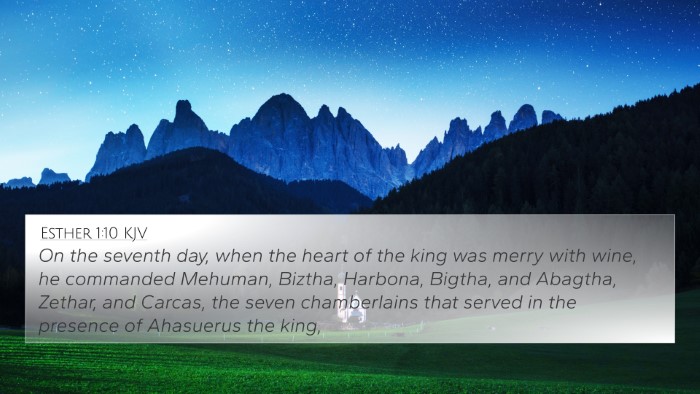
Esther 1:10 (KJV) »
On the seventh day, when the heart of the king was merry with wine, he commanded Mehuman, Biztha, Harbona, Bigtha, and Abagtha, Zethar, and Carcas, the seven chamberlains that served in the presence of Ahasuerus the king,
Esther 2:2 Verse Analysis and Similar Verses
Understanding Esther 2:2
The verse Esther 2:2 states, "Then the king’s servants who attended him said, 'Let beautiful young virgins be sought for the king.'" This verse marks a pivotal point in the narrative of Esther, initiating the process of selecting a new queen after Vashti's refusal to obey King Ahasuerus's command. This request by the king's attendants highlights several key themes, including beauty, selection, and the dynamics of power in the royal court.
Contextual Analysis
The context of Esther 2:2 provides insight into the socio-political climate of the Persian Empire under King Ahasuerus. The decision to search for young women reflects both the king's authority and the role of beauty in attracting favor within the court. As highlighted in public domain commentaries:
- Matthew Henry: Henry emphasizes the king’s desire to replace Vashti and the service of his attendants in fulfilling the king's wishes. He considers how this reflects the nature of human desire and the fleeting nature of beauty.
- Albert Barnes: Barnes notes that the search for beautiful virgins was a common practice in royal courts, indicating both the extravagance and the patriarchal society of the time.
- Adam Clarke: Clarke brings attention to the implications of the terminology used, underscoring that 'beautiful young virgins' were seen as prized possessions in the courtly environment.
Thematic Connections
The themes present in Esther 2:2 connect to other scriptural passages, providing a broader understanding of beauty, God's providence, and human agency. Below are several key connections and cross-references:
- Proverbs 31:30: "Charm is deceitful, and beauty is vain, but a woman who fears the Lord is to be praised." This verse contrasts with the focus on physical beauty by emphasizing inner virtue.
- 1 Samuel 16:7: "For the Lord sees not as man sees: man looks on the outward appearance, but the Lord looks on the heart." This verse highlights the contrast between divine and human values in assessing worth.
- Esther 1:11: "To bring Queen Vashti before the king with her royal crown, in order to show the peoples and the princes her beauty." This earlier verse sets the stage for the king's subsequent search for a new queen.
- Song of Solomon 4:7: "Thou art all fair, my love; there is no spot in thee." This verse reflects the ideal of beauty celebrated in the scriptures.
- 1 Peter 3:3-4: "Do not let your adornment be external—the braiding of hair and the putting on of gold jewelry, or the clothing you wear—but let your adorning be the hidden person of the heart…" These verses reinforce the biblical ideal of inner beauty.
- Esther 4:14: "For if you keep silent at this time, relief and deliverance will rise for the Jews from another place..." This indicates God’s providence and purpose, showing that Esther's beauty had a significant role in God's plan for His people.
- Isaiah 3:16: "The Lord said: Because the daughters of Zion are haughty and walk with outstretched necks, glancing wantonly with their eyes…" This verse critiques external beauty absent of godliness, providing a moral backdrop to Esther's narrative.
Interpretation and Reflections
The call for beautiful young virgins as initiated by the king's servants can also reflect greater theological themes:
- The selection process of Esther serves as a metaphor for God's choosing of individuals for specific roles in His grand narrative.
- Esther’s journey from obscurity to prominence illustrates God's providential hand, signifying that even in worldly kingdoms, God's purposes prevail.
- Exploring the dynamics of power and beauty invites reflections on how society values and prioritizes attributes, often neglecting the deeper virtues that God seeks in His people.
Practical Applications
For contemporary readers, Esther 2:2 serves as a reminder of the significance of one's inner character versus physical appearance. It encourages believers to seek qualities that honor God rather than merely conforming to cultural standards of beauty. In addition, Esther's story offers a template for courage, wisdom, and divine purpose in the face of challenging circumstances.
Further Study
Those interested in deeper explorations can utilize tools for Bible cross-referencing to draw thematic correlations between Esther and other scriptures. Here are some suggested methods:
- Bible Concordance: Utilize a concordance to trace similar terms and themes across the text.
- Cross-Reference Bible Study: Engage in comparative analysis of texts that share thematic elements with Esther 2:2.
- Cross-Referencing Biblical Texts: Create a map of connections between Esther and related passages for a comprehensive understanding.
In summary, Esther 2:2 opens the door to rich thematic discussions and connections with a multitude of scripture. Engaging with these biblical narratives through cross-referenced studies enhances our understanding of God's divine purpose and invites deeper reflection on our values and behaviors in relation to His Word.
